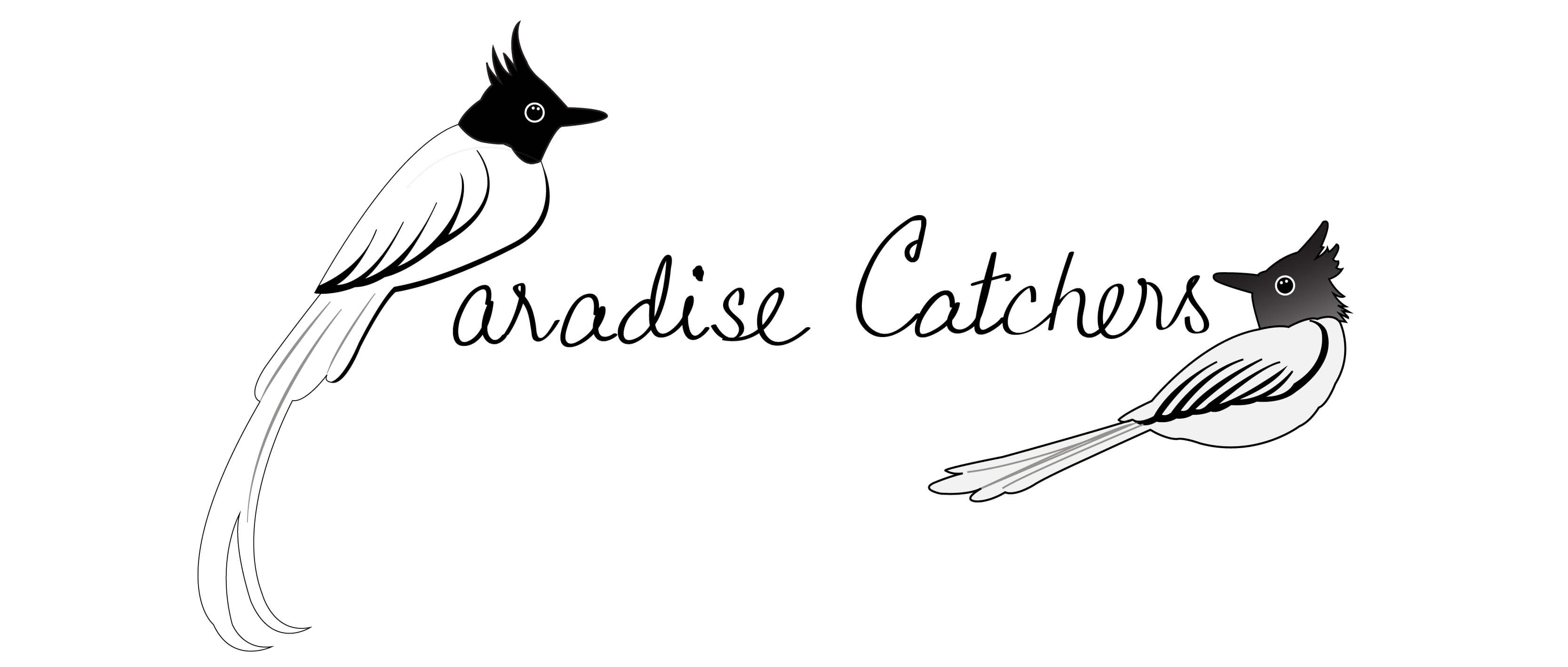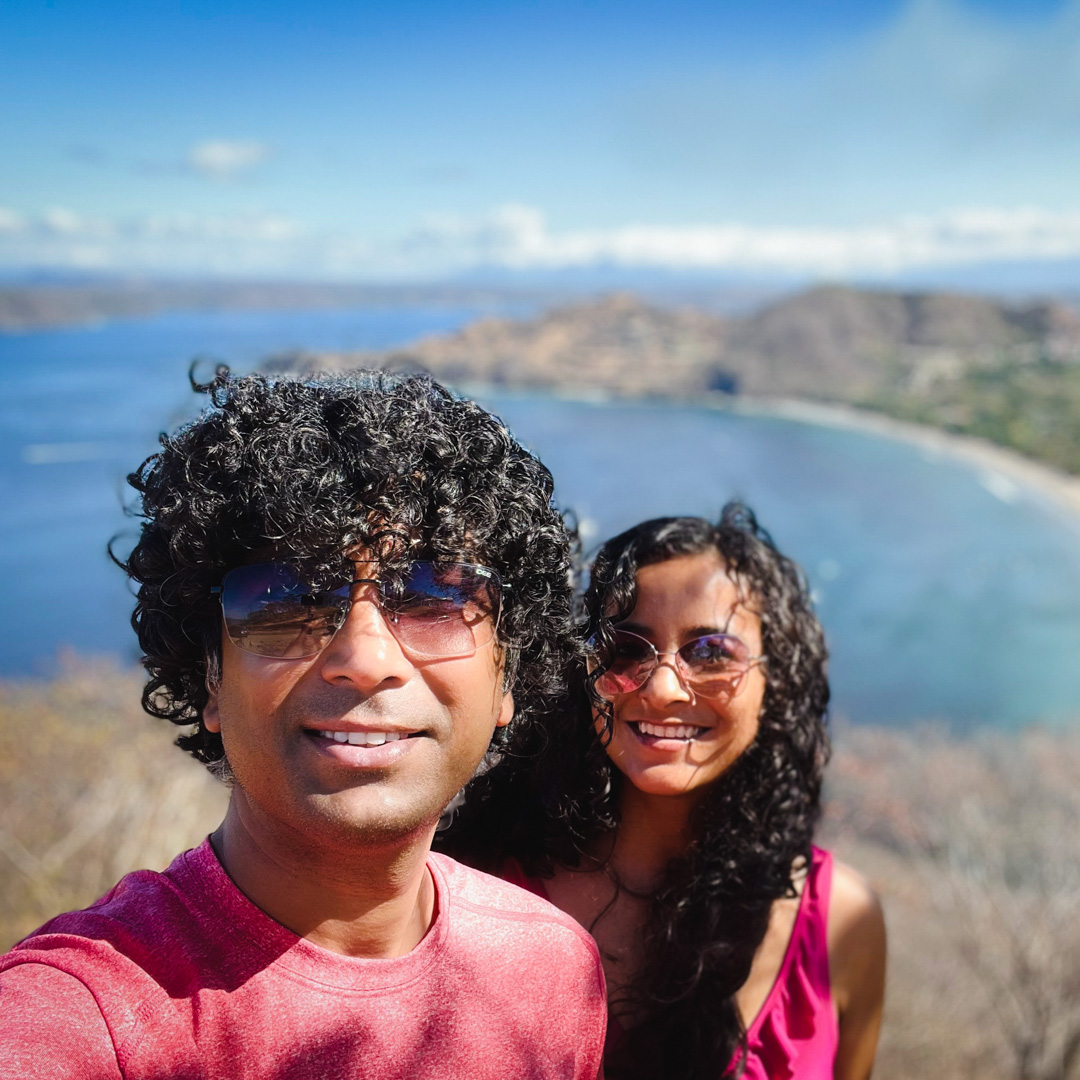Caribbean Sea shoreline, lagoons and small towns on narrow elongated strips of land, all run parallel to each other, just next to a large national park, creating the unique topography of Tortuguero, Costa Rica.
As we looked at the mobile screen live feed of our drone’s flight over Tortuguero, our emotions reached heightened levels of astonishment. Tempted to see more of the aerial views of the distinctive landscape, we ignored the device’s low battery alert and estimated that the landing could be done in time. But the drone had other plans. It decided to initiate landing, while flying over the Tortuguero Lagoon! Long story short, we were able to save it. However, it did involve Indranil kayaking across the lagoon filled with caimans and crocodiles, to pick up the drone from a deserted jungle island!
As you can guess, Tortuguero is wild. The network of land and water, the absence of any road connection with the rest of the country, the conservation efforts to protect forest and wildlife make nature thrive in Tortuguero in its own isolated world. No wonder, this Caribbean town is often referred to as the Little Amazon of Costa Rica.
Tortuguero is a small town but it has plenty to offer to the offbeat nature seeker. This is our travel guide to Tortuguero, with the details on the best things to do, how to reach, where to stay and where to eat.
Tortuguero, Costa Rica: The Inspiring Story of Transformation
Tortuguero may seem like a model destination for sustainable tourism, where the economy thrives on conservation of nature and wildlife. But the town had to go through a long journey of unlearning and learning to be where it is now.
Once upon a time, the primary means of livelihood for Tortuguero people depended on destroying forests and killing sea turtles. Logging companies cut down trees but provided jobs to the locals. Foreign merchants offered money for turtle meat and shell, that encouraged the locals to kill the turtles.
As research progressed and awareness spread, people started focusing on the protection of their natural resources. That drew the attention of conservationists and wildlife enthusiasts to Tortuguero. The locals saw the opportunity of a transformation of their economy and gradually embraced the change. In 1970, Tortuguero National Park was established. It currently protects 76,937 hectares of marine and terrestrial area.
Today, what remains from that history are discarded logging machinery left behind by the logging companies. Those rusty machines are now used as town center decor. And the people who would hunt turtles for money, became the first generation of naturalist guides for turtle tours.
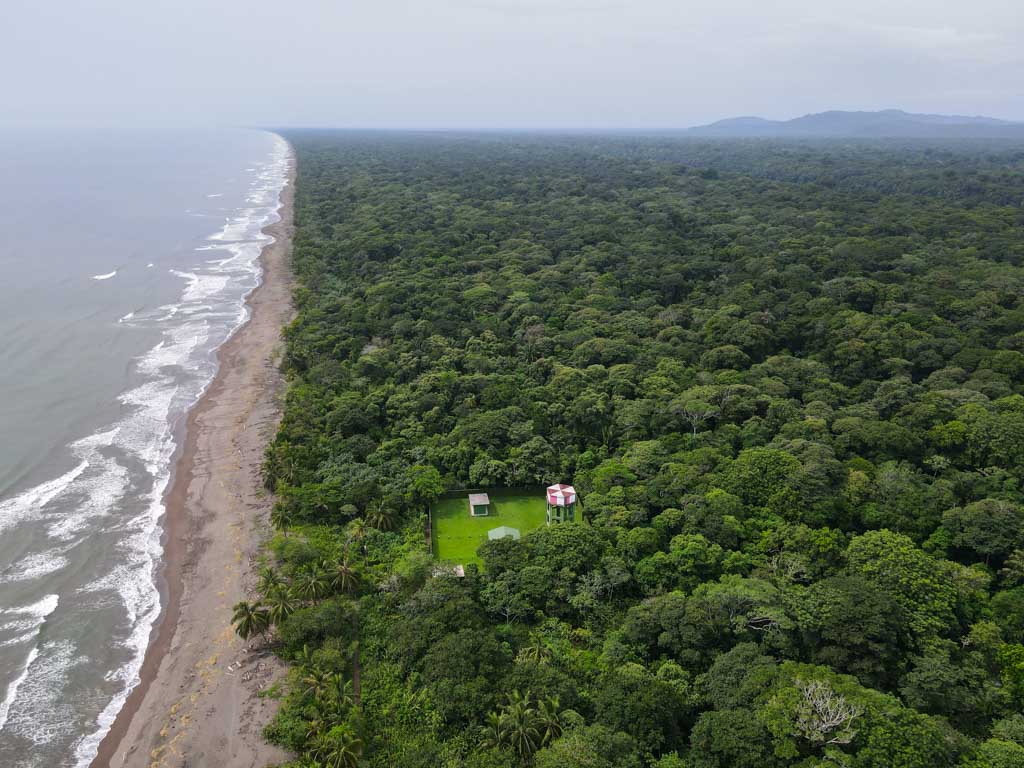
10 Things to Do in Tortuguero, Costa Rica
The best things to do in Costa Rica revolve around nature and wildlife. But some of the experiences in Tortuguero are unique to the region. Some of the activities are available at specific hours only. So, you can plan your itinerary around those and fit in other activities for the day accordingly.
Turtle Nesting Tour
Turtle Nesting Tour is the prime reason to visit Tortuguero for most people. It is a highly specialized tour offered by experienced guides only. You cannot do this on your own.
Tortuguero beach is the most important turtle nesting site of the western hemisphere. Between the months of July and October, thousands of green sea turtles arrive at this beach to lay their eggs at night. During their respective nesting seasons, other species of sea turtles like loggerhead, hawksbill and leatherback also come to Tortuguero beach for nesting. However, green sea turtles are the most common to spot because they arrive in large numbers.
On the nesting tour, the guide takes you to the beach in the darkness of the night when you can witness this wonderful natural phenomenon of turtles nesting. Since this is a sensitive tour, there are strict guidelines to adhere to. The guide will brief you on the same before the start of the tour.
The tour takes place inside Tortuguero National Park, lasts for around 2 hours and costs 35-40 USD per person.
We went for a turtle nesting tour in Tortuguero in the month of August, when we could see the nesting process of one giant green sea turtle. It was a magical experience – you can read about the whole process and our experience in this post.
Tortuguero National Park – Canoe Tour
Network of canals and lagoons crissscross the land sections of Tortuguero National Park. So an interesting way to explore the national park is to take a canoe tour. As the canoe slowly navigates through the canals for 3 hours, you get to spot different birds, animals and reptiles – on land and in or near water.
Some tour providers offer silent motor canoes while others have canoes with rows. The person operating the canoe is also your naturalist guide who will help you spot wildlife.
During our tour in a silent motor canoe, we spotted lots of aquatic birds like jacana, green ibis, different types of herons, reptiles like caimans and crocodiles, and a semiaquatic mammal, river otter. The canoe ride is a tranquil experience as the only sounds you can hear are those of birds, animals, leaves, water and occasional rain drops on water.
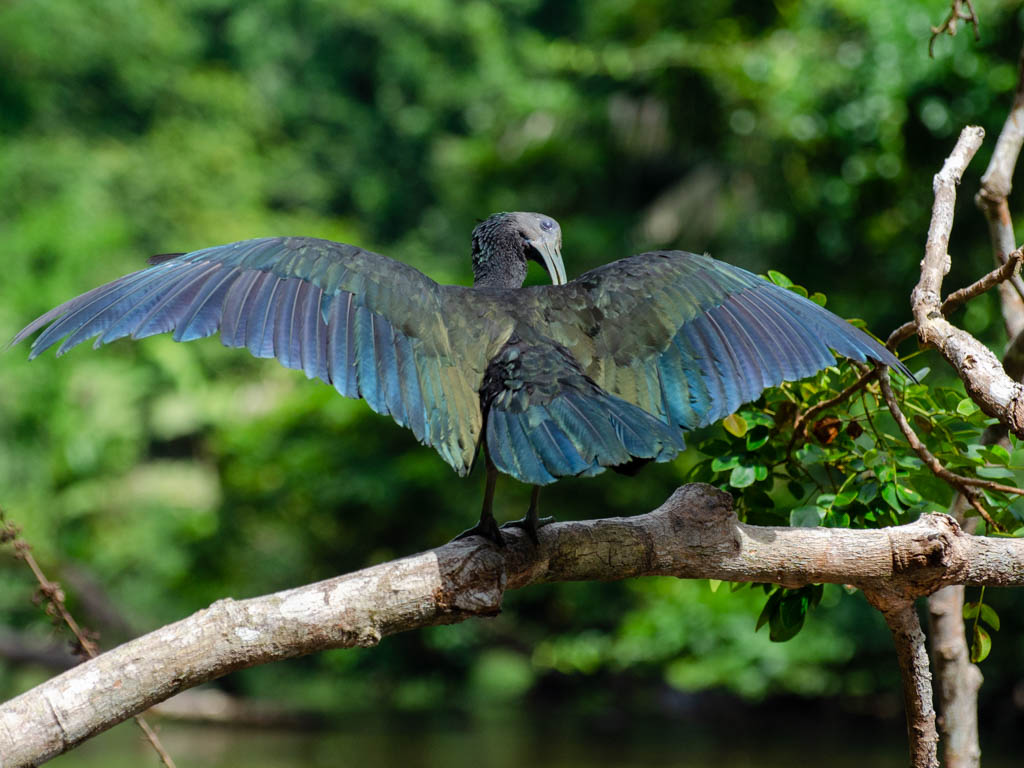
Tortuguero National Park – Kayaking
Another great way to explore the canals of Tortuguero National Park is kayaking.
You can go on a guided kayak tour or rent a kayak and explore on your own. The waters are calm and it is easy to get into the canal and navigate through the water system. However, having a guide will possibly give you a better wildlife viewing experience. We would also recommend a guided kayak tour if you do not have prior experience of kayaking.
You should be aware, although they are not a threat to humans, that caimans and crocodiles reside in these waters.
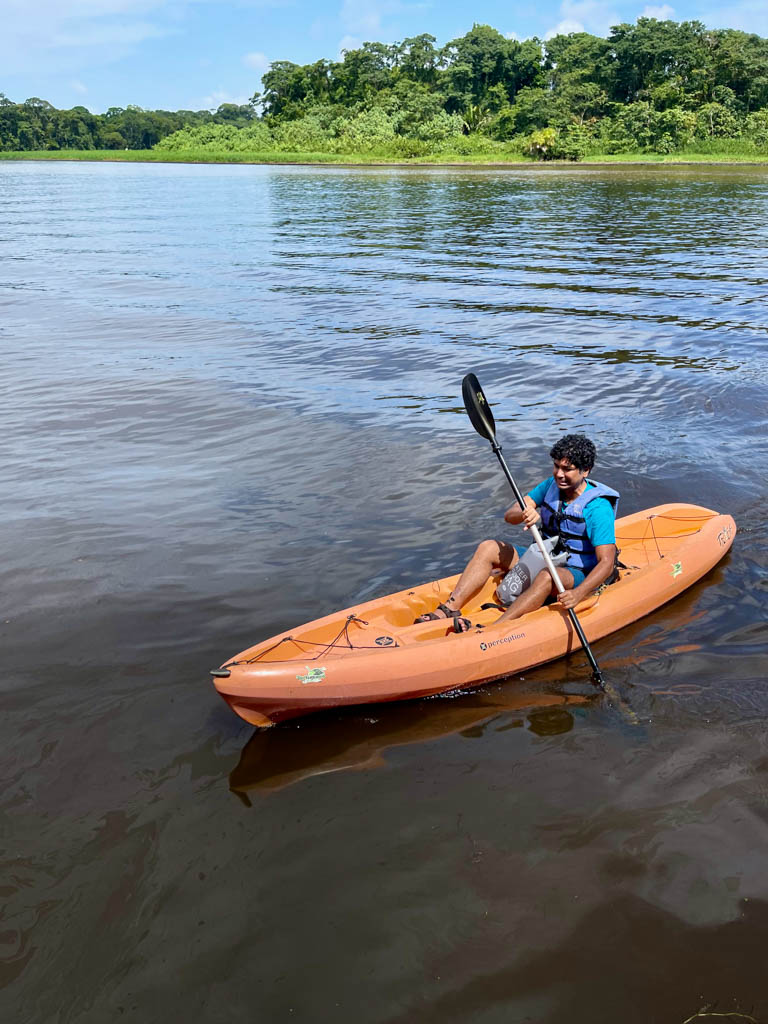
Tortuguero National Park – Jungle Hike
Although the turtle nesting tour and the canoe/kayak tours are more exciting ways to experience Tortuguero National Park, a walk in the jungle is not to be dismissed. Especially when the trail is called “Jaguar Trail”. It gets its name due to a sizeable jaguar population in the area.
But before you start rolling your eyes or start to get too excited, let me tell you that the odds of coming across a jaguar during this jungle hike are really low. Still, you need to be prepared about how to respond in case you do come in close proximity of a jaguar. There is a large sign board at the entrance of the park explaining all the steps you need to follow on such an occasion. We read the instructions, took a photo of the same for reference and started the hike with a faint hope of having to use those instructions. No, we did not get that chance. Remember, the chances are next to none.
Guided or Self-guided?
A naturalist guide will share the knowledge about Tortuguero’s history and the unique features and the benefits of the flora of the ecosystem, and will also help you spot wildlife in the most difficult of places. However, if your main intention is just a nature walk or seeing animals and birds, and if you are familiar with the wildlife of Costa Rica and their behavior, you can do this hike on your own. We had a great time on the guided tour, but if we do this again, we plan to go on a self-guided hike.
The trail is flat and easy, but some sections are muddy and can get worse during or after rains. So, remember to rent a gumboot, whether you go on your own or with a guide.
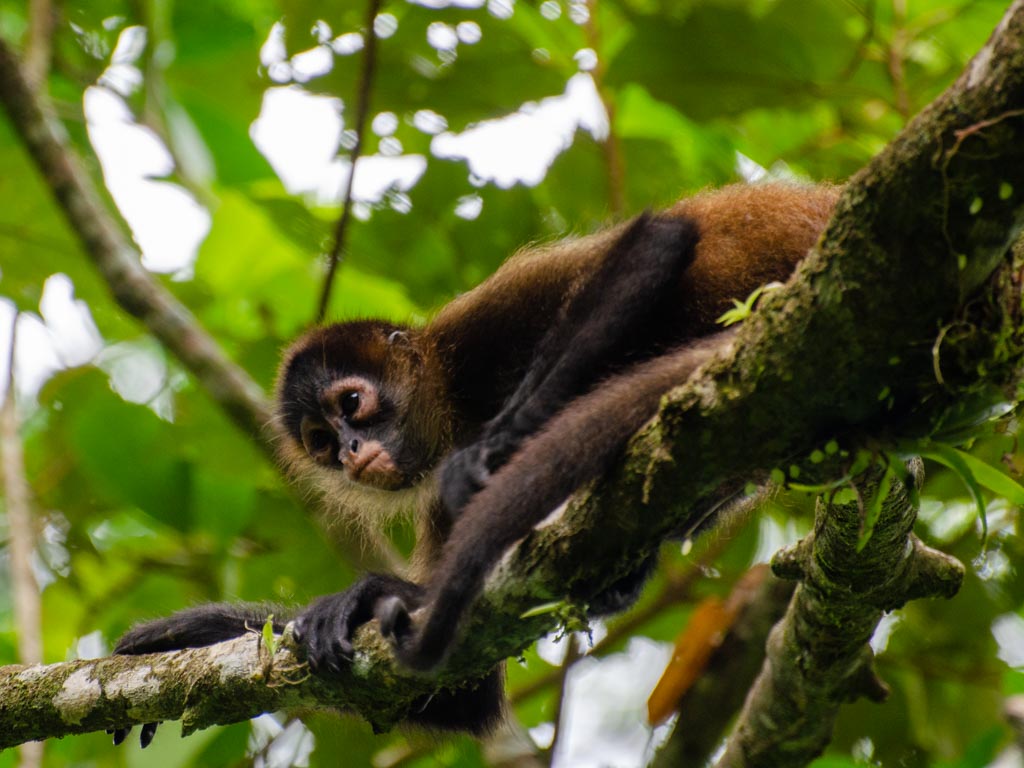
Cerro Tortuguero Hike
Tortuguero National Park, with its diverse offerings of wildlife experiences, is the star attraction of any Tortuguero travel plan. But, Cerro Tortuguero (Tortuguero Mountain) can also be a wonderful addition to your Tortuguero itinerary.
It is an inactive volcano formed 1.8 billion years ago and is the point of highest elevation on the Caribbean plains of Costa Rica. It is a fairly easy hike to reach the volcano summit where from you can enjoy amazing views of the landscape consisting of sea, lagoons, hills, forests and towns. Keep an eye out for wildlife as you walk on the trail and hang out at the observation deck at the top.
For your trip to Cerro Tortuguero, you can allocate some time to explore the nearby village of San Francisco de Tortuguero. Without much development of tourism, here you can find the raw charm of a small and vibrant Caribbean community.
Read this guide for all the details about how you can go on a self-guided trip to Cerro Tortuguero.
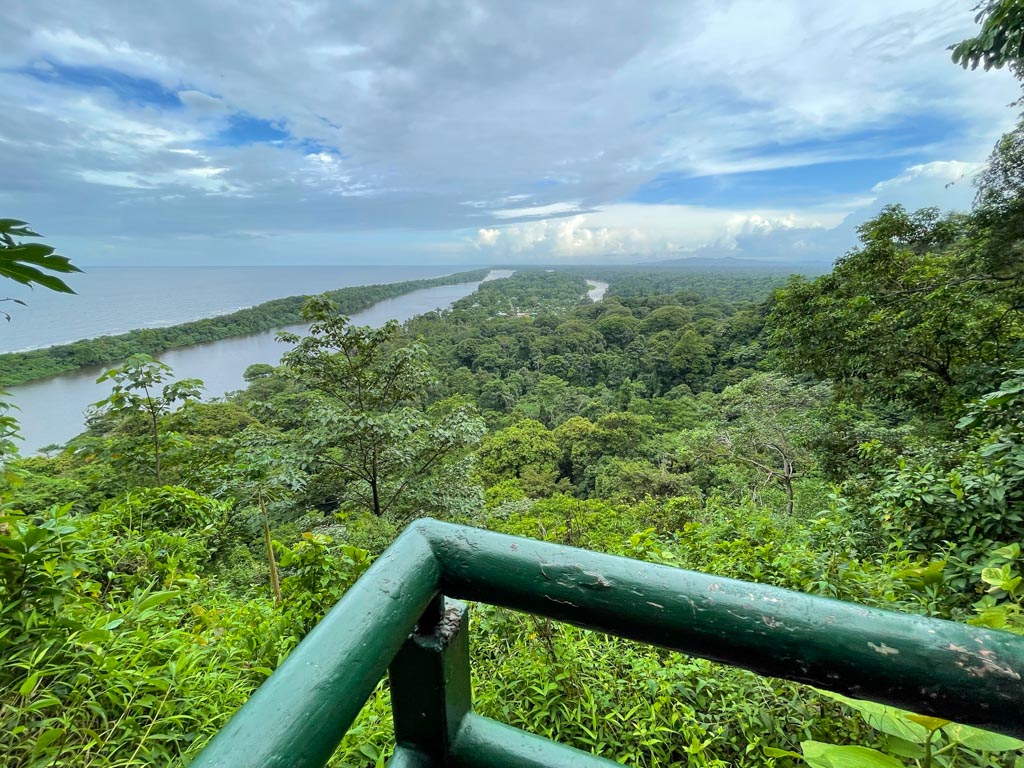
Canopy Tour
Canopy tour or zip-lining is one of the best things to do in Costa Rica. Although zip-lining over the cloud forests in Monteverde is the most popular zip-lining in the country, you will find plenty of other places offering such tours, including Tortuguero.
For your Tortuguero canopy tour, you will be zip-lining among the deep rainforests of the region, getting to see a distinct perspective of the region’s topography. The canopy tour track includes 7 cables, 4 suspension bridges, 11 platforms and 1 Tarzan Swing. The tour takes around 1.5 hours and the price usually includes transportation from your hotel in Tortuguero.
You can book the Tortuguero Canopy Tour from your hotel’s travel concierge desk or through one of the local tour providers in Tortuguero.
Jungle Night Walk
Similar to canopy tour, you will get the chance to go on a jungle night walk tour in different places of Costa Rica. However, the tours differ from one another as you get to see wildlife specific to the area where you are taking the tour. Even for the same animal, you can spot different variants of the same species from one place to another.
There are two main areas where the Jungle Night Walk is conducted in Tortuguero. One of them is better in terms of spotting reptiles and amphibians, whereas in the other, you have higher chances of spotting nocturnal mammals. Prior to your tour, discuss your interests and expectations with your guide so that he/she can design the tour to give you the best experience.
Related reading: Our night walk experience in Monteverde
Explore Tortuguero Town
Your days in Tortuguero are likely to be filled with several activities. Yet try to find the time to walk around and explore the town on your own. The length of the main town center is only 900 meters. But you can observe so much character as you walk up and down the main street.
Apart from the obvious presence of restaurants and tour company offices, you will get to see the life of the locals. Depending on the time of day, you may spot young people preparing to start their day’s work or children having a field day at the football ground or families gathering at the beach to spend some quality time together.
The center of the town is a vibrant place with wall graffiti and colorful art installations representing Costa Rican biodiversity. Notice the interesting dustbins that collect cigarette butts and cigarette packets in a way to form decorative art. This town seems to specialize in making art from scrap as there are many discarded rusty logging machinery spread across town. The logging company does not exist in Tortuguero anymore. However, these iron junks serve no purpose other than being decorative pieces.
There is a Sea Turtle Conservancy Museum that you can visit in town. You can learn more about sea turtles and their life at this museum. The museum is open between 10:00 am and 12:00 noon, and between 2:30 pm and 5:00 pm.
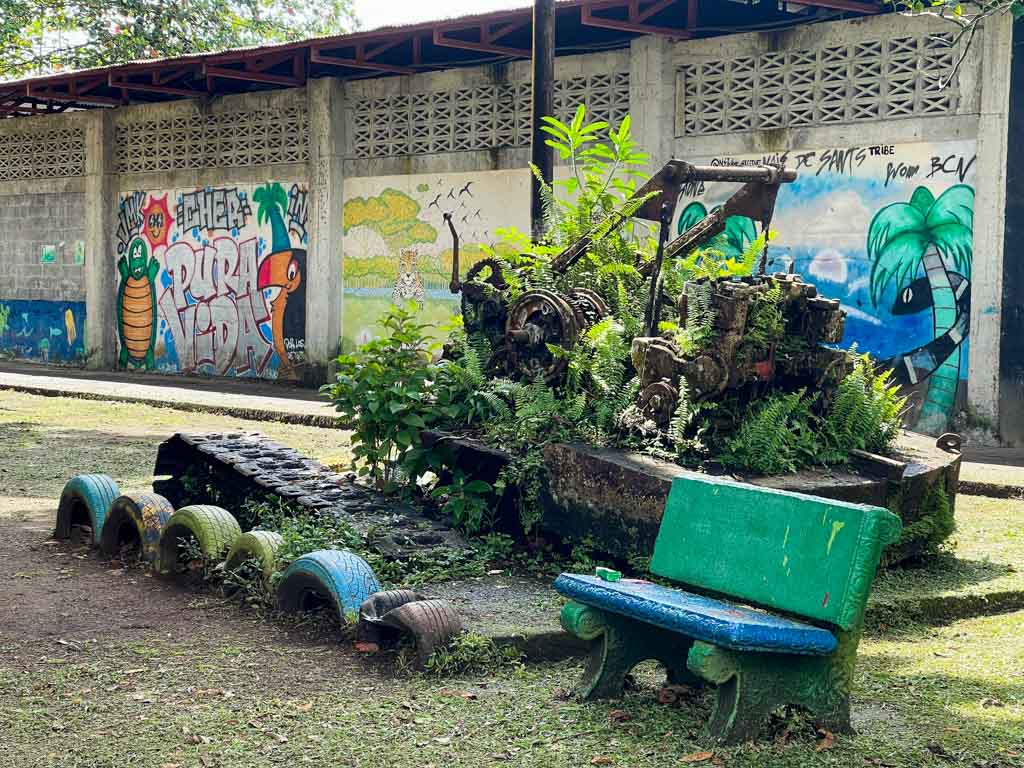
Bean to Bar Chocolate Making
After participating in the physically demanding tours, if you want to spend some relaxing time in Tortuguero, sign up for a chocolate tour. Casa Cecropia, located near the entrance of the Tortuguero National Park, offers this tour.
The tour provides an in-depth cacao and chocolate experience for a duration of 2 hours. The journey starts from visiting the orchard of cacao trees, and then goes on to explain the entire process of bean-to-bar chocolate making. But the most interesting part is that you get to participate hands-on throughout the entire process. By the end of the tour, you would have made your own chocolate!
The tours are offered two times a day, at 10:30 am and at 4:00 pm. The cost is 25 USD. You do need to reserve in advance. You can contact Casa Cecropia on WhatsApp at +506 8829 8523 to make the reservation or to inquire about private group tours.
Caribbean Jungle Spa
If you want to take your relaxation one notch up, sign up for a Caribbean jungle spa session. The rustic spa cottage in the lush jungle setting seemed perfect for spending a calming afternoon. Let the masseuses work on relaxing your tired muscles as you fall asleep to the sounds of nature.
We have not tried this ourselves yet in Tortuguero. But we had once got ourselves a couple massage session at one of the jungle spas in Puerto Viejo de Talamanca, a beach town in the south Caribbean part of Costa Rica. If we go by that experience, it was wonderful.
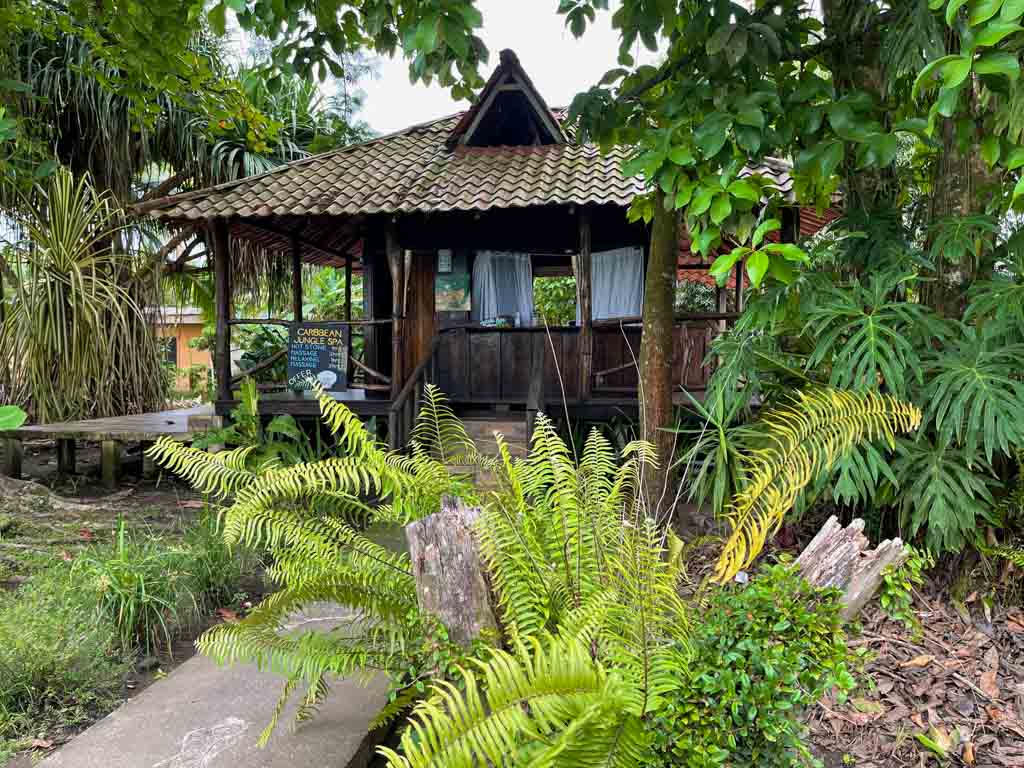
How to Get to Tortuguero
There is no road network connecting Tortuguero to the rest of Costa Rica. Thus the only two ways to get to Tortuguero are by domestic plane or by boat.
Check out Tortuguero’s unique geographic positioning on Google Maps. Because of this location, the journey to Tortuguero is not just a transfer, but a wonderful travel experience by itself.
Read this post for all details about how to get to Tortuguero by air or by boat from different destinations like San Jose, La Fortuna or the Caribbean towns of Puerto Viejo de Talamanca or Cahuita.
Best Time to Visit Tortuguero, Costa Rica
Located on the Caribbean side of Costa Rica, Tortuguero receives rainfall almost all year round. However, September and October are comparatively drier, when the Caribbean part of the country gets its short summer. In terms of temperature, it varies between 22 to 32 degrees C (72 to 90 degrees F), depending on the time of the year.
You can visit Tortuguero any time of the year, because you can get sunny days during the rainy season and it can rain during the dry season. The green sea turtles nesting season is from July to October. The baby turtles start to hatch from September/ October. So, if you want to optimize your chances of seeing turtle nesting, baby turtles hatching and getting good weather all at once, September and October would be the best time to visit Tortuguero.
Packing Tips for Tortuguero, Costa Rica
Packing for Tortuguero requires a bit more planning than your usual trips. You are likely to be participating in activities in water and on land. There will be tours during the day and at night. The weather can be hot and it can rain too. But the challenge is to pack for all these possible combinations in small or medium sized luggage as the main transport is via boat or walking. You will have no rental car or taxi where you can keep loose items spread out here and there in different compartments.
Some basic tips to keep in mind while packing for Tortuguero:
- Clothes: Light weight quick dry clothes. Dark clothes for turtle nesting tour.
- Footwear: Closed toed walking/ hiking shoes. Hiking sandals that work in water too.
- Sunscreen. Insect repellent spray/cream.
- Rain ponchos/ raincoats.
- Dry bag for storing your valuables in the case of rain or other water activities.
- Water bottle for refilling. Tap water in Tortuguero is potable.
Tortuguero Hotels: Where to Stay?
There are some luxury resorts off the main town of Tortuguero. But the hotels, guesthouses and hostels are located near the main town center.
All of the resorts and some hotels offer package deals that include accommodation, tours, meals and transport from San Jose. If getting to Tortuguero seems like a challenge, you may consider availing a package deal.
Luxury Hotels and Resorts
- Mawamba Lodge: Located bit north of the main town area, it is a couple’s choice accommodation with tropical settings, outdoor pool and rustic decor. Check prices and availability here.
- Pachira Lodge: Located across the canal from the main Tortugueo town, it is a large resort with outdoor pool, sun terraces and Tortuguero’s only Canopy Tour. Check prices and availability here.
- Aninga Lodge: Another large resort, highly rated for couple stays, near the same location with outdoor pool and free WiFi. Check prices and availability here.
- Tortuga Lodge & Gardens: A waterfront property with river view rooms, outdoor pool, free WiFi and onsite restaurant. The lodge is a 10-minutes boat ride away from town. Check prices and availability here.
Mid-range Accommodation
- Tortuguero Adventures Guesthouse: Waterfront guesthouse with river view rooms, attached balcony, simple but neat large rooms and free WiFi. Check prices and availability here.
- Budda Home: A newly opened accommodation extension of the cafe/restaurant of the same name. Located in town, the apartment style stay options carry the same zen vibes as the cafe decor. Check prices and availability here.
Budget Accommodation
- Cabinas Tortuguero: Set 200 meters from Tortuguero National Park, this is a hostel style accommodation offering cabins with shared or private bathrooms, terraces with hammocks and free WiFi. Check prices and availability here.
- Chinitas Eco Lodge: Located in San Francisco de Tortuguero, this lodge offers rooms with private bathrooms, patios with garden views and free WiFi. Check prices and availability here.
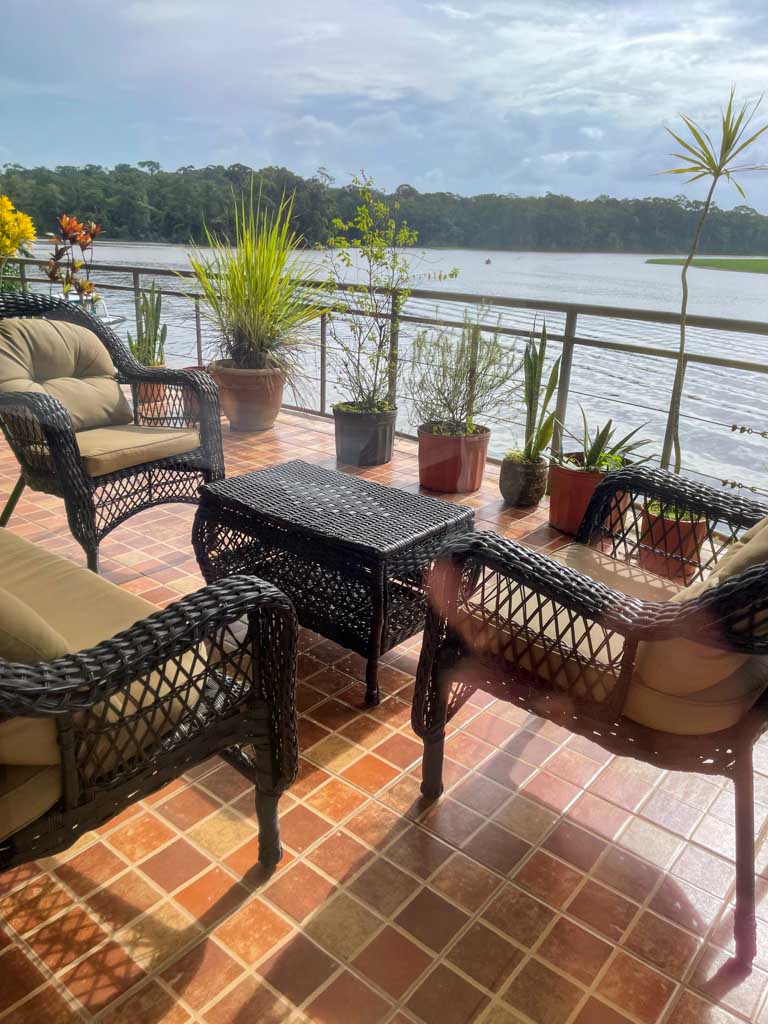
Tortuguero Restaurants: Where to Eat?
Tortuguero town center is filled with lines of eateries. Based on our experience, here are a few we can recommend.
Restaurants
Budda Cafe: It is a waterfront restaurant with a zen inspired decor. The cafe menu offers Mediterranean dishes and a variety of pizzas, along with hot and cold beverages. Do try their mango cheesecake for dessert!
Restaurante Mi Nino: A small but popular restaurant serving Caribbean/ Costa Rican dishes. The tastes are good, and the presentations impeccable. Order one of their smoothies to go with your meal.
Soda D’Leite: Local soda serving Costa Rican/ Central American focused dishes. One of the few restaurants in town that are open even for breakfast.
La Culebra: A small soda that does not get very good reviews online. But our meal of tacos and burritos there was not bad. And their mango juice was one of the freshest and tastiest I have had in Costa Rica.
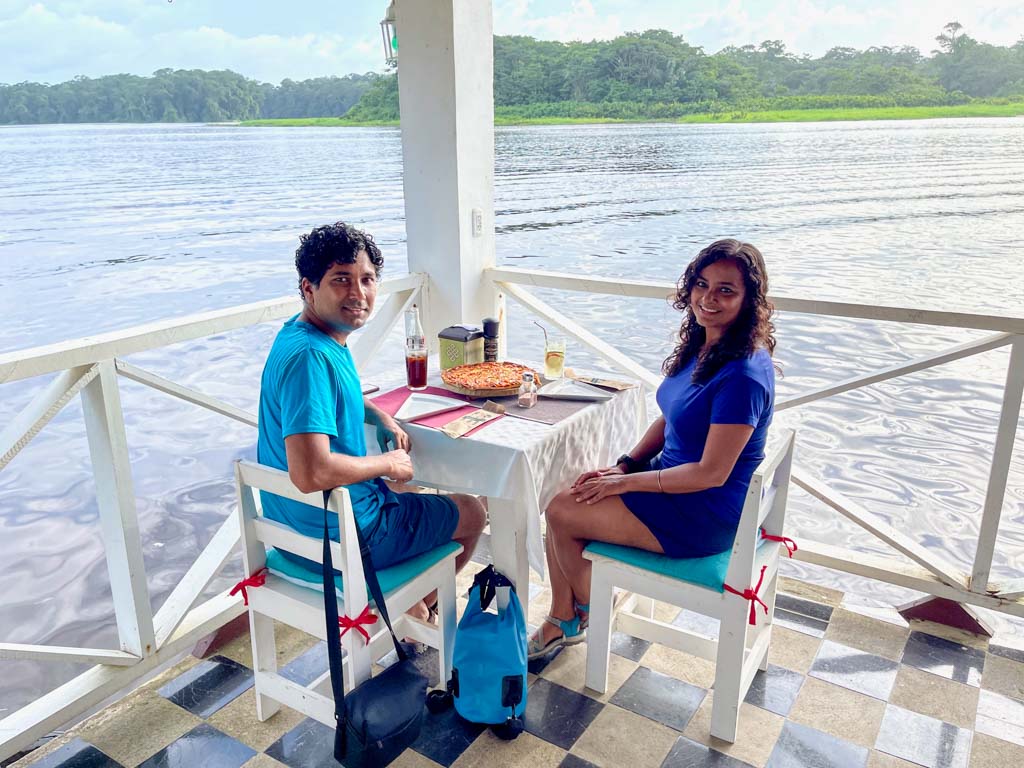
Street Food
But our best meal experience in Tortuguero was not at any of the restaurants.
As you walk down the street, you will notice many family owned food stalls, selling tortillas con queso y crema (tortillas with cheese and cream), and pinchos de pollo (chicken skewers). We had one such dinner from a grandma and her family’s food stall near the Tortuguero town center. It reminded us of similar such street food scenes in Cartagena and the interactions we had there with a Colombian family.
The tortillas and pinchos from the family-run food vendors in Tortuguero are easy on the pocket, taste delicious, and your purchase in turn directly helps the local family business. Ain’t that a win-win?
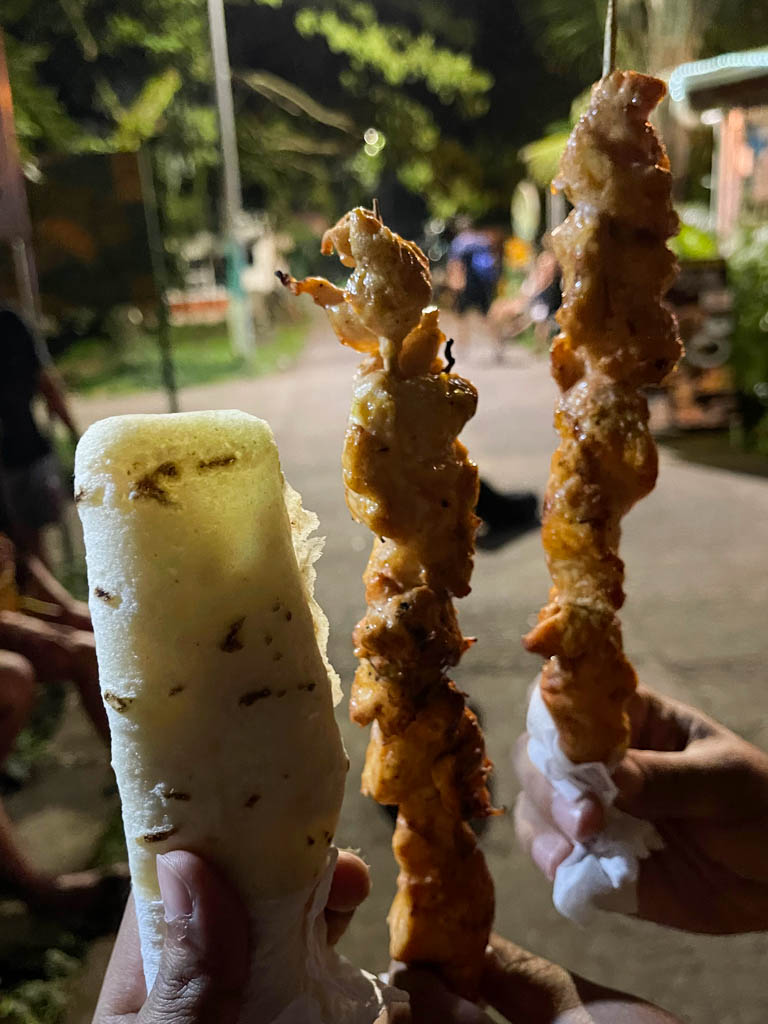
Final Thoughts on Tortuguero, Costa Rica
Tortuguero is unlike any other destination of Costa Rica. No waterfalls to chase, no waves to surf, no white or golden sand beaches to laze on, no mountains to scale, yet Tortuguero stirred us with its natural abundance and its historic journey that led to it.
If you want to get lost in a seemingly faraway land for a few days, where your closest interactions are with the sights and sounds of nature, consider adding Tortuguero to your Costa Rica travel itinerary.
Like the post? Pin it!


Disclosure: Please note that this post contains affiliate links. If you make a purchase or a booking through these links, we may earn a commission at no extra cost to you. Thank you.
